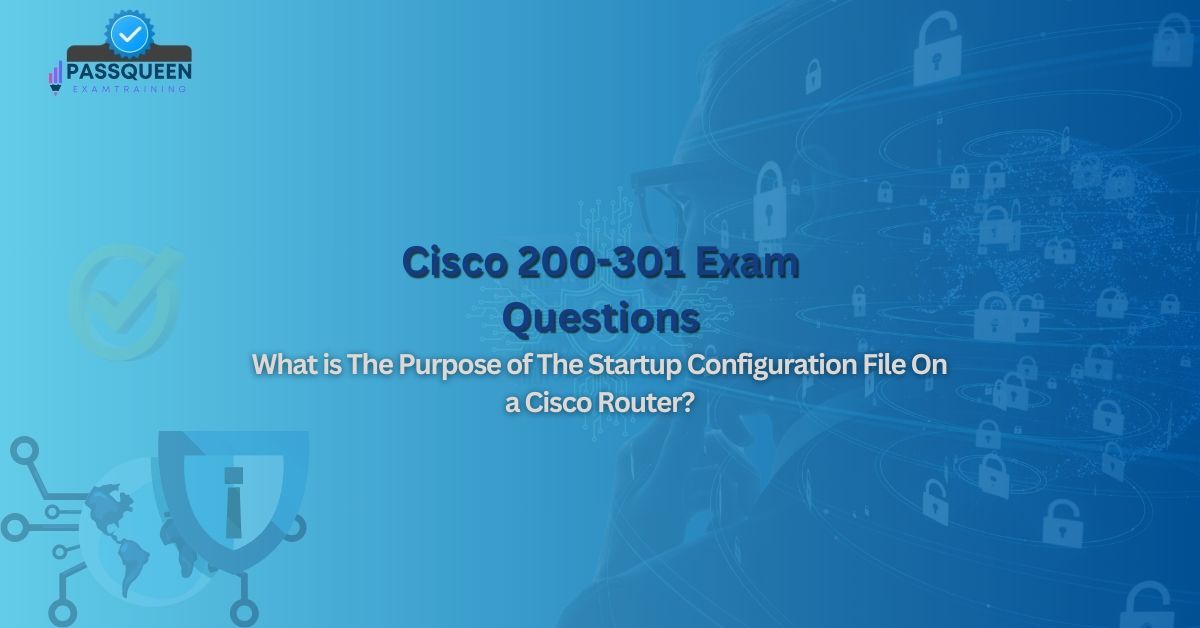Introduction: The Critical Role of Configuration Files in Cisco Certification
For network professionals pursuing Cisco CCNA 200-301 certification, mastering router configuration files is absolutely essential. These files serve as the DNA of Cisco devices, containing all the instructions that determine how routers and switches operate. At PassQueen, we recognize that understanding configuration files—particularly the startup-config file—is a fundamental skill tested on the Cisco CCNA Exam Questions and required in real-world network administration. This comprehensive guide will explore the purpose and operation of Cisco's configuration files, with special emphasis on the startup configuration, providing you with the knowledge needed to excel in your certification exam and beyond.
The Importance of Configuration Files in Cisco Devices
Configuration files in Cisco devices serve several critical functions:
1. Device Personality: They transform generic hardware into specifically configured network equipment
2. Operational Blueprint: They contain all commands needed for proper device functioning
3. Consistency Maintenance: They ensure devices maintain their configuration across reboots
4. Disaster Recovery: They serve as backups for restoring device configurations
For CCNA candidates, understanding these files is crucial because:
· Approximately 15-20% of exam questions relate to device management
· Configuration file management appears in multiple exam objectives
· Real-world troubleshooting often involves configuration file issues
Overview of Cisco Router Configuration Files
Cisco devices primarily work with two configuration files:
1. Running-config (running configuration):
o Active, in-memory configuration
o Changes take immediate effect
o Lost during power cycle if not saved
2. Startup-config (startup configuration):
o Stored in NVRAM (non-volatile memory)
o Loaded during device bootup
o Persistent across reboots
Key differences between these files:
|
Characteristic |
Running-config |
Startup-config |
|
Storage Location |
RAM |
NVRAM |
|
Persistence |
Temporary |
Permanent |
|
Modification |
Changes take immediate effect |
Requires copy command to update |
|
Purpose |
Current device operation |
Baseline for boot process |
The Purpose of the Startup Configuration File
The startup-config file serves several vital purposes in Cisco devices:
1. Boot-Time Configuration:
o Provides initial configuration when device powers on
o Serves as the baseline for device operation
2. Configuration Preservation:
o Maintains device settings during power cycles
o Preserves configuration during unexpected outages
3. Disaster Recovery:
o Acts as backup for device configuration
o Enables configuration restoration when needed
4. Consistency Assurance:
o Ensures devices return to known state after reboot
o Maintains uniform configuration across network devices
5. Change Management:
o Provides reference point for configuration changes
o Helps identify unauthorized modifications
How the Startup Configuration Works
The startup-config file operates through a specific lifecycle:
1. Storage:
o Resides in NVRAM (non-volatile RAM)
o Persists without power
o Can be copied to external storage (TFTP servers)
2. Loading:
o Accessed during boot process (after POST)
o Copied into RAM as running-config
o Applied line-by-line during initialization
3. Updating:
o Modified by copying running-config to startup-config
o Updated via copy
running-config startup-config command
o Can be edited directly in NVRAM (not recommended)
4. Verification:
o Viewed using show
startup-config command
o Compared with running-config for changes
Common Scenarios Involving Startup-Config
CCNA candidates should understand these frequent startup-config scenarios:
1. Forgotten to Save Changes:
o Technician makes changes to running-config
o Forgets to copy to startup-config
o Device reboots and loses all changes
2. Corrupted Configuration:
o Startup-config becomes damaged
o Device may enter setup mode
o Requires configuration restoration
3. Password Recovery:
o Startup-config bypassed during recovery
o Original config maintained in NVRAM
o Can be restored after password reset
4. Device Replacement:
o Startup-config copied to new device
o Ensures consistent configuration
o Minimizes service disruption
5. Configuration Rollback:
o Previous startup-config versions maintained
o Can revert to known good configuration
o Useful after problematic changes
Essential Tips to Prepare for Cisco 200-301 Exam
To master configuration file concepts for the CCNA exam:
1. Memorize Key Commands:
o copy
running-config startup-config
o show
running-config / show startup-config
o erase
startup-config
2. Understand the Boot Process:
o POST → Load IOS → Load startup-config
o What happens when no startup-config exists
3. Know Storage Locations:
o Running-config → RAM
o Startup-config → NVRAM
o IOS → Flash
4. Practice Scenario-Based Thinking:
o What happens if...
o How would you recover when...
o Where would you look for...
5. Use Simulation Tools:
o Cisco Packet Tracer
o GNS3
o Real equipment if available
6. Focus on Troubleshooting:
o Configuration recovery procedures
o Password recovery process
o Dealing with corrupted files
Practice Questions for Configuration File Mastery
1. "What happens if you modify running-config but don't save to startup-config?"
o Answer: All changes will be lost when the device reboots because running-config resides in volatile RAM, while startup-config in NVRAM maintains the persistent configuration.
2. "Where is the startup-config stored?"
o Answer: In NVRAM (Non-Volatile Random Access Memory), which retains information even when power is removed.
3. "How do you save your current configuration to the startup-config?"
o Answer: Use the command copy
running-config startup-config or the shorter version wr (write) in older IOS versions.
4. "What command shows the difference between running and startup configurations?"
o Answer: show archive
config differences or third-party tools in more recent IOS versions.
5. "What happens when a router boots with no startup-config?"
o Answer: The router will enter setup mode or initial configuration dialog, as there is no saved configuration to load.
Conclusion: Mastering Configuration Files for Exam and Career Success
Understanding Cisco configuration files, particularly the startup-config, is fundamental for both the CCNA 200-301 exam and real-world network administration. The startup-config file serves as the backbone of router operation, preserving the device's configuration across reboots and providing a recovery point when needed. By mastering the concepts covered in this guide—the purpose of startup-config, its operation, common scenarios, and essential commands—you'll be well-prepared for configuration-related questions on the CCNA exam.
PassQueen recommends hands-on practice with Cisco devices or simulators to reinforce these concepts. Remember that while the exam tests your knowledge, real-world networking challenges your ability to apply that knowledge. Use the practice questions provided to test your understanding, and revisit any areas where you feel less confident.
Sample Cisco 200-301 Exam Questions
What is the purpose of the startup configuration file on a Cisco router?
A) To store the current operating configuration of the router
B) To preserve the router's configuration across reboots
C) To hold temporary configuration changes during editing
D) To store the IOS image for router operation
Correct Answer: B) To preserve the router's configuration across reboots
Explanation: The startup configuration file's primary purpose is to preserve the router's configuration across reboots. It is stored in NVRAM (non-volatile memory) and loaded into RAM as the running-config when the router boots. Option A describes the running-config, option C describes temporary configuration buffers, and option D describes the IOS image stored in flash memory.













